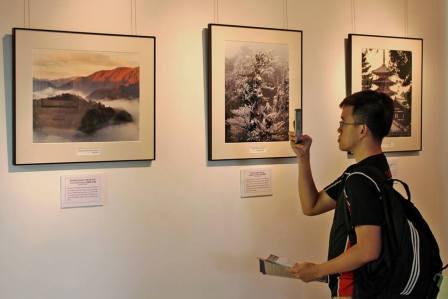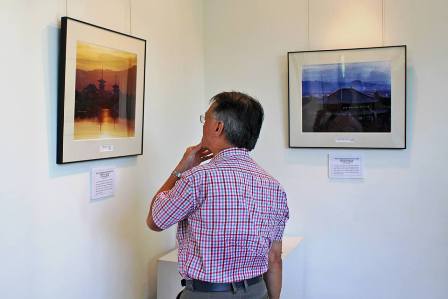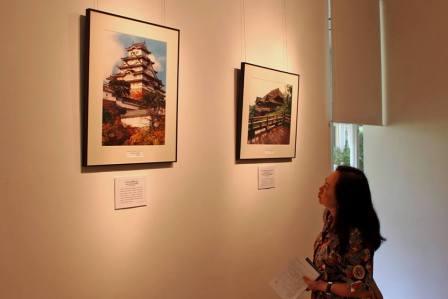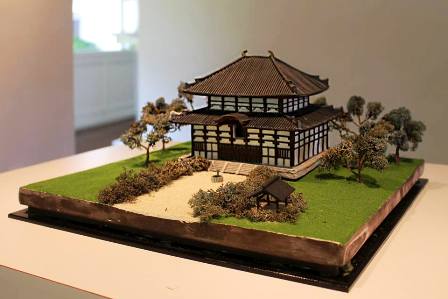
Guest having a look at the World Heritage Portraits
A World Heritage Site is a place (such as a building, city, complex, desert, forest, island, lake, monument, or mountain) that is listed by the United Nations Educational, Scientific and Cultural Organization (UNESCO) as being of special cultural or physical significance. This list is maintained by the International World Heritage Programme administered by the UNESCO World Heritage Committee, which comprises of 21 UNESCO member states elected by the General Assembly.
UNESCO aims to preserve cultural and natural legacies that possess conspicuous and universal value for future generations. This exhibition therefore, seek to underline the importance of heritage as a cornerstone of our collective history, our present and our legacy. Japan with her diverse natural beauty and a long, distinctive cultural history, has produced a rich variety of buildings and other cultural properties which exists today. Japan has a total of 18 sites (14 cultural heritage sites and 4 natural heritage sites) on the World Heritage List as the data of 2014
In this photography exhibition, visitors were visually treated to a collection of photographs clicked mainly by Mr Kazuyoshi Miyoshi who was awarded the youngest winner of the prestigious Kimura Ihei Photography Award at 27 years old. Many of his works are displayed as a permanent collection in the George Eastman House International Museum of Photography and Film in the United States. Photo panels were supported by the Japan Foundation, Kuala Lumpur.
The following were the 18 sites (14 cultural heritage sites and 4 natural heritage sites) that were displayed in this exhibition (until 2014):
UNESCO World Heritage in Japan
http://www.mofa.go.jp/policy/culture/coop/unesco/c_heritage/w_heritage/property.html
http://whc.unesco.org/en/statesparties/jp
14 Cultural Heritage Sites
_____________________________________________________________________________________
4 Natural Heritage Sites
As the latest news, as the decision of 39th Session of the World Heritage Committee of UNESCO in Bonn, Germany, from 28th June to 8th July 2015, this committee adopted a resolution that decides to inscribe the following sites related to Japan on the 5th July and Singapore on the 4th July 2015.
・Sites of Japan’s Meiji Industrial Revolution: Iron and Steel, Shipbuilding and Coal Mining (Reference 1)
・Singapore Botanic Gardens (Reference 2)
We would like to take this opportunity to congratulate the Singapore Botanic Gardens for being inscribed as a UNESCO World Heritage Site in 39th Session of the World Heritage Committee of UNESCO in Bonn, Germany, from 28th June to 8th July 2015! This year, we celebrate the 50th anniversary of Singapore’s independence. On top of that, we now celebrate the UNESCO World Heritage Site inscription, which we truly believe marks a profound milestone for the nation.

Guest having a look at the World Heritage Portraits
|

Guest having a look at the World Heritage Portraits
|

Display of UNESCO Site Model
|

Display of Books and Brochures about Japan |
_____________________________________________________________________________________
Reference 1:
Sites of Japan’s Meiji Industrial Revolution: Iron and Steel, Shipbuilding and Coal Mining
Description Link: Click Here
Photo Gallery Link: Click Here
Statement by the Minister for Foreign Affairs of Japan on the Inscription of “The Sites of Japan’s Meiji Industrial Revolution: Iron and Steel, Shipbuilding and Coal Mining” on the UNESCO’s World Heritage List. Click Here
The site encompasses a series of eleven properties, mainly located in the southwest of Japan. It bears testimony to the rapid industrialization of the country from the middle of the 19th century to the early 20th century, through the development of the steel industry, shipbuilding and coal mining. The site illustrates the process by which feudal Japan sought technology transfer from Europe and America from the middle of the 19th century and how this technology was adapted to the country’s needs and social traditions. The site testifies to what is considered to be the first successful transfer of Western industrialization to a non-Western nation.The sites in the series reflect the three phases of this rapid industrialisation achieved over a short space of just over fifty years between 1853 and 1910.
The first phase in the pre-Meiji Bakumatsu period, at the end of Shogun era in the 1850s and early 1860s, was a period of experimentation in iron making and shipbuilding. Prompted by the need to improve the defences of the nation and particularly its sea-going defences in response to foreign threats, industrialisation was developed by local clans through second hand knowledge, based mostly on Western textbooks, and copying Western examples, combined with traditional craft skills. Ultimately most were unsuccessful. Nevertheless this approach marked a substantial move from the isolationism of the Edo period, and in part prompted the Meiji Restoration.
The second phase in the early 1870s brought in with the new Meiji Era, involved the importation of Western technology and the expertise to operate it; while the third and final phase in the late Meiji period (between 1890 to 1910), was full-blown local industrialization achieved with newly-acquired Japanese expertise and through the active adaptation of Western technology to best suit Japanese needs and social traditions, on Japan’s own terms. Western technology was adapted to local needs and local materials and organised by local engineers and supervisors.
The 23 nominated components are in 11 sites within 8 discrete areas. Six of the eight areas are in the south-west of the country, with one in the central part and one in the northern part of the south island. Collectively the sites are an outstanding reflection of the way Japan moved from a clan based society to a major industrial society with innovative approaches to adapting western technology in response to local needs and profoundly influenced the wider development of East Asia.
After 1910, many sites later became fully fledged industrial complexes, some of which are still in operation or are part of operational sites.
Reference 2:
Singapore Botanic Gardens
Description Link: Click Here
Photo Gallery Link: Click Here
Situated at the heart of the city of Singapore, the site demonstrates the evolution of a British tropical colonial botanic garden that has become a modern world-class scientific institution used for both conservation and education. The cultural landscape includes a rich variety of historic features, plantings and buildings that demonstrate the development of the garden since its creation in 1859. It has been an important centre for science, research and plant conservation, notably in connection with the cultivation of rubber plantations, in Southeast Asia since 1875.
Founded at its present site in 1859, Singapore Botanic Gardens forms part of the long colonial tradition of creating European-style botanic gardens in the tropics. This internationally renowned tropical botanical garden, the oldest surviving of its kind in the Straits Settlements, has a rich heritage and is a dynamic and living testament to the foresight of the early pioneering spirit of Singapore. Throughout its long and illustrious history, it has played an integral role in Singapore's cultural, social and economic development and is a site that provides historical reference to Singapore's Garden City concept and the ideals of Singapore's founding fathers.
Whilst the city's urban landscape has changed tremendously over the past 50 years, the botanic gardens, which now extends over c.74h was preserved, forming a valuable green oasis in the midst of the compact and densely populated city centre of Singapore. As the only historic botanic garden in Singapore and one of few historic landscape gardens on the island, it contributes greatly towards providing a sense of history, place and identity to Singaporeans and visitors. It remains the premier and most popular park in the city, counting more than 4 million visits per annum.

